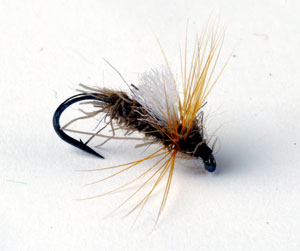It bears a good resemblance to many food forms for the trout, especially midges and sedges. The deer hair fibres used in the dubbing mix add buoyancy and ‘confusion’ to the overall shape of the pattern, giving the illusion of a hatching insect.
While this could be fished in a team of other dry flies, it’s perhaps best fished on its own at the end of a 12ft to 16ft 4lb leader on a floating line.
Unless absolutely necessary, avoid putting floatant on this fly – you want it to sit IN the surface, not on it.
Hook: Kamasan B400 size 10 to 14
Thread: Brown
Body: Hare’s ear and deer hair blend
Wing: White Antron yarn
Hackle: Ginger cock
Thorax/head: Hare’s ear and deer hair blend
How To Tie The Fly
 |
| 1. Wind the thread down the hook shank (stopping opposite the area between barb and point) in touching turns. |
|
 |
| 2. In the palm of your hand, blend a bunch of hare’s ear dubbing with short-cut strands of deer hair. |
|
 |
| 3. Form a rope on the thread by rolling the dubbing on in one direction. |
|
 |
| 4. Making touching turns, form a body using the dubbing rope. |
|
 |
| 5. Double over a piece of yarn and tie it in, so that it lies back over the body. |
|
 |
| 6. Trim the Antron to half the body length, then tie in a hackle by its base. |
|
 |
| 7. Make three to four turns with the hackle, stroking the fibres back as you go. Tie it off and clip away the stalk. |
|
 |
| 8. Form a thorax and head by winding another dubbing rope in front of the hackle. Whip finish and varnish. |
|
 |
| 9. Carefully cut away the underside of the hackle – this helps the fly sit nicely in the surface film. |
|
Total Fly Fisher















